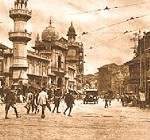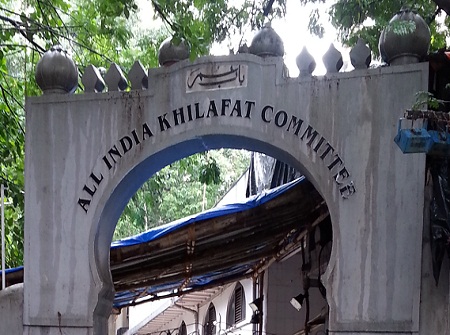Khilafat House is located in a leafy Byculla lane in south Mumbai. The entrance arch of this historic landmark proudly bears the name: All India Khilafat Committee (AIKC). The original bungalow was rebuilt many years ago and the compound now houses the Khilafat College. This new role belies Khilafat House’s historic importance, not just to the Indian nationalist movement, but also to an international pan-Islamism during World War I and in its immediate aftermath, when the fate of the Ottoman Caliphate was being decided.
At a time when events of global importance are unfolding in West Asia, the militant Islamic State is relentlessly advancing, and its leader has resurrected the office of the Caliph, it is interesting to look back to the reverberations felt in Mumbai when the Ottoman Caliphate, as well as its temporal control over Islam’s most holy sites, were both endangered.
In those pre-Independence decades, Mahatma Gandhi achieved a coup of sorts (against opposition from within the Congress and by other political groupings): he combined the Khilafat (Caliphate) cause with the anger and frustration at the British government’s response to the Jallianwala Baug massacre (on 13 April 1919) to launch his first Non-Cooperation Movement from Bombay.
Most of the standard works, such as the Encyclopaedia Britannica, which refer to Mumbai during the Great War, talk of the ambivalence of Indian Muslim communities towards Britain going to war with the Ottoman Empire. Although various political parties supported World War I, the feelings were mixed when British Indian troops launched a campaign in Mesopotamia in October 1914 at the Shatt-al-Arab, then a part of the Ottoman Empire.
This personalised the war—triggered by the Balkan States—and made it a Holy War, because the Ottoman Caliph was not just the temporal head of a vast territory, he was also the spiritual head of the Islamic world. Accordingly, the office of the Caliph moved from Cairo to Damascus to Istanbul at various periods in history, across empires that were responsible for the security of Islam’s holiest sites.
In West Asia now, the leader of the Islamic State, Abu Bakr al-Baghdadi, has declared himself Caliph in the captured city of Mosul: this highlights the still emotive appeal of the Caliphate, a spiritual and temporal position ordained in the Koran.
In South Asia nearly a 100 years ago, Indian Muslims became increasingly disaffected with the prolonged campaign of the British Indian Army in Mesopotamia. Delegations from the subcontinent appealed to the Amir of Afghanistan to launch a Holy War to defend the Caliphate. Even then, the call to war led many Muslim peasants to abandon their village homes and trudge over the frozen high passes in a perilous journey from India to Afghanistan; this is perhaps reminiscent of the young men from neighbouring Thane recently taking the leap into the Iraqi war zone, as have many from across the world today.
It must be noted, however, that the Khilafat movement was formally launched only after the end of World War I, when the fate of the Ottoman Empire hung in balance. It coincided with the imposition of the draconian Rowlatt Act in February 1919. Instead of greater autonomy for the subcontinent, as promised at the beginning of the war, the Act left nationalist leaders feeling cheated.
Gandhi’s embrace of the Khilafat movement, founded by the fiery Ali brothers Maulana Mohammed Ali (after whom Mohammed Ali Road is named) and Shaukat Ali, and Maulana Abul Kalam Azad (all well-known nationalists), made it one of the main planks of the Non-Cooperation Movement. It became a movement that showcased Hindu-Muslim unity.
Gandhi was elected president of the First All-India Khilafat Conference in 1919. The first Id-e-Milad procession from Khilafat House (originally Chhotani House in the Masjid area in south Mumbai) to Haj House behind Jyotiba Phule Market (Crawford Market), was led by Gandhi as head of the AIKC. The tradition of this annual procession has continued uninterrupted all these years, though it now starts from the AIKC headquarters in Byculla and then goes to Haj House.
Both movements—Khilafat and Non-Cooperation—ended abruptly. The Khilafat movement was cut short by Kemal Ataturk, the first president of Turkey, in 1924, when he declared post-war Turkey a secular state. Two years earlier, sporadic outbreaks of violence on the sub-continent, culminating in the Chauri Chaura incident, also led Gandhi to call off the Non-Cooperation Movement.
These crucial five years (1919 to 1924) in India’s nationalist history are now depicted on the walls of Khilafat Hall: framed photographs of the Ali brothers, of the First All-India Khilafat Conference, of Gandhi addressing rallies. They remain silent witnesses to an epochal slice of global history that is linked to Mumbai.
The author would like to thank the management of Khilafat College for enabling a visit to the college hall on a holiday.
Sifra Lentin is a Mumbai-based writer and historian, and the Mumbai History Fellow at Gateway House: Indian Council on Global Relations.
This article was exclusively written for Gateway House: Indian Council on Global Relations. You can read more exclusive content here.
For interview requests with the author, or for permission to republish, please contact outreach@gatewayhouse.in.
© Copyright 2014 Gateway House: Indian Council on Global Relations. All rights reserved. Any unauthorized copying or reproduction is strictly prohibited




